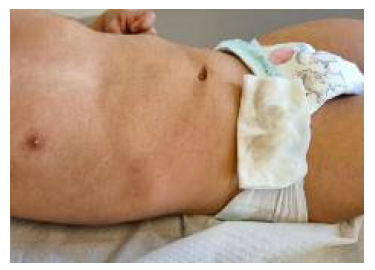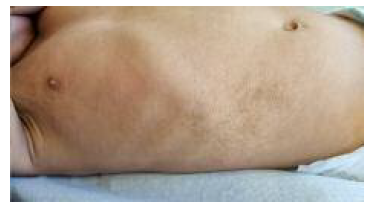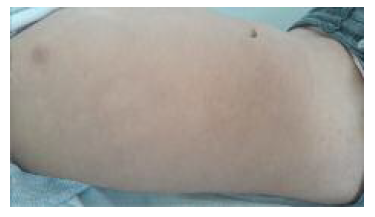Introduction
Terra firma-forme dermatosis (TFFD) is a benign disease, described for the first time in 1987 by Duncan, Tschen, and Knox in the Archives of Dermatology. It is also known as Duncan’s dirty dermatosis.1
There is no apparent predilection of gender nor any clear evidence of familial predisposition, 1 although genetic predisposition and an association with atopic dermatitis and xeroderma have been mentioned by Aslan et al.,2 and Stiube et al.,3 respectively. Children and young adults have a higher risk, but it can affect people of any age1 and sex. 2
Its prevalence and incidence are unknown because it is an underdiagnosed disorder. 4 The etiology remains unknown, but it is hypothesized that TFFD results from delayed maturation of keratinocytes with incomplete development of keratin squames, and retention of keratinocytes and melanin within the epidermis. 3 The main characteristics of this dermatosis are its slightly elevated morphology with brown and black-coloured, hyperkeratotic, and asymptomatic plaques and papules. They can pass as dirt to an untrained eye. 4
Case description
This case is about a healthy 3-year-old girl, who presented in our clinic with a 6-month history of brownish spots that looked like ‘dirt’, which were spread through the chest and flanks. The mother tried to scrub with soap and water but without improvement of the lesions. After examination, we suspected terra firma-forme dermatosis, so we rubbed it with a gauze embedded in 70% isopropyl alcohol, and the plaques were removed. (Fig 1, and 2) Then, we recommended the daily use of a smoothing cream with a keratolytic agent like salicylic acid in the treated areas to accelerate the healing and complete the resolution of the lesions. After two months, the child presented without any lesions. (Fig 3)

Figure 2 Right flank without brownish lesions after rubbing with gauze soaked in 70% isopropyl alcohol.
Comment
Additional diagnostic and treatment may incur if TFFD is not considered earlier. However, TFFD is easily diagnosed and treated. 2 Dermatosis neglecta (DN) and acanthosis nigricans (AN) are the two major differential diagnoses. 5 DN can affect people of any age with poor hygiene. 5 The lesions can be removed with soap and water, 4-5 alcohol swabs, or an alcohol cotton ball. 5 On the other hand, AN lesions consist of a dark thickening of the skin, more frequent in the nape and neck area, usually associated with metabolic disorders, like obesity5 and insulin resistance. 3 This hyperpigmentation cannot be removed either by alcohol swab or cotton ball, 5 or by soap and water. 3,5
A naked eye examination is the usual technique for the clinical diagnosis of TFFD. 1 Dermoscopy can be used, and it shows brown polygonal plate-like scales, organized in a mosaic or cobblestone pattern. 1 Histological evaluation, when performed, can reveal acanthosis, papillomatosis, and lamellar hyperkeratosis. 1 The application and rubbing of 70% isopropyl alcohol allow the complete clearing of the TFFD lesions. 1-5 However, the lesions may recur. 4
The therapeutic options are many and they are not restricted to the 70% isopropyl alcohol. 1 Since TFFD has shown a good response to keratolytic, urea-based keratolytic (in association with a topical anti-inflammatory, such as tacrolimus, to attenuate the inflammatory response), alpha hydroxy acid salts (e.g., ammonium lactate), topical retinoids, salicylic acid, or bland acids like squeezed lemon juice can also be used. These agents should be preferred in specific TFFD presentations, such as early onset, genital or facial involvement, and widespread disease, instead of alcohol swabbing. 1 As reported by Badaró et al.4 the use of 5% salicylic acid once a day for two weeks showed a good response, as well as the treatment with CO2 laser cited by Sechi et al.,1 which could be considered as a valid therapeutic option. Therefore, the association of chemical peeling and alcohol base should be considered for a better cosmetic result. 3 The application of emollients is also important for preventing xerosis caused by the recurrent use of alcohol. 1,4
Terra firma-forme dermatosis is a benign condition, easy to diagnose and treat, so it is important to make an early diagnosis to prevent unnecessary diagnostic and treatment procedures.
Author contributions
Conceptualization, IC, MIS, GC, AIP, and SG; methodology, IC, MIS, GC, AIP, and SG; investigation, IC, MIS, GC, AIP, and SG; resources, IC, MIS, GC, AIP, and SG; writing - original draft preparation, IC, MIS, GC, AIP, and SG; writing - review and editing, IC, MIS, GC, AIP, and SG. All authors have read and agreed to the published version of the manuscript.

















